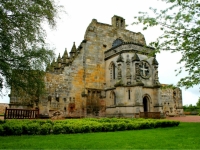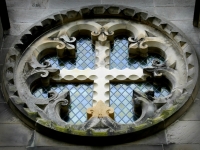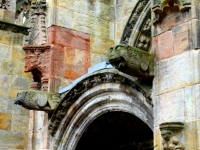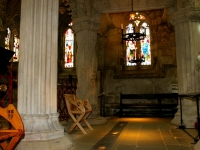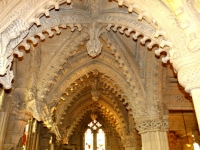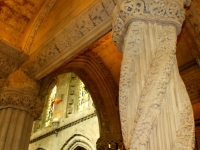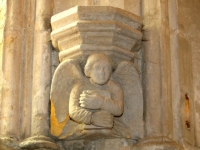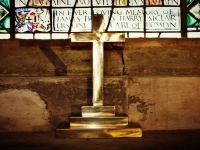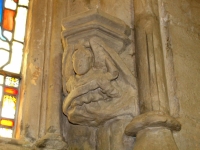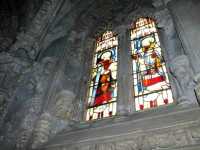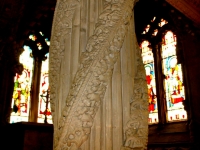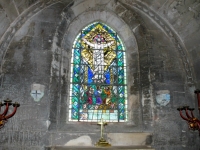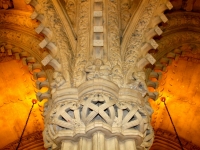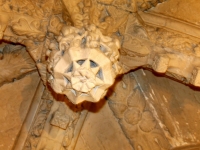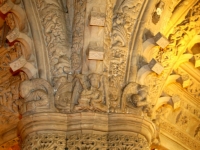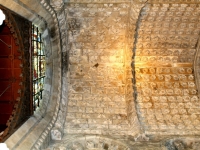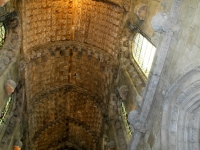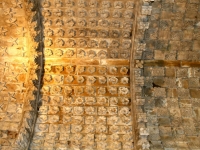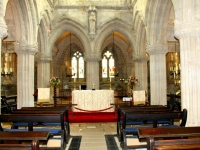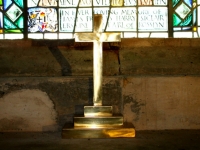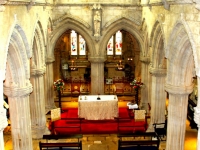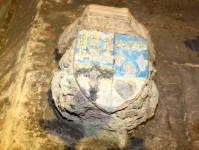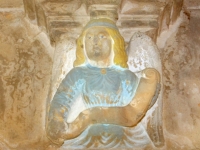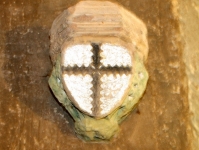Travel
Rosslyn Chapel
15th century Scottish Chapel
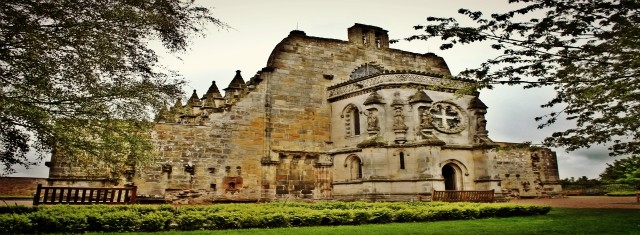
Rosslyn Chapel (Source: © 2014 Daren Frankish)
USPA NEWS -
A mid-15th century Chapel. Rosslyn Chapel and the nearby Roslin Castle are located at the village of Roslin, Midlothian, Scotland.The chapel was founded by William Sinclair, 1st Earl of Caithness. Formally known as the Collegiate Chapel of St Matthew.
55°51“²19“³N 3°09“²37“³W
Source: Mixed Media
55°51“²19“³N 3°09“²37“³W
Source: Mixed Media
The chapel was founded by William Sinclair, 1st Earl of Caithness Rosslyn Chapel is the third Sinclair place of worship at Roslin, the first being in Roslin Castle and the second was what is now Roslin Cemetery. The purpose of the college was to celebrate the Divine Office throughout the day and night and also to celebrate Holy Mass for all the faithful departed, including the deceased members of the Sinclair family. During this period the rich heritage of plainsong or polyphony would be used to enrich the singing of the liturgy. An endowment was made that would pay for the upkeep of the priests and choristers in perpetuity and they also had parochial responsibilities.
After the Scottish Reformation (1560) Roman Catholic worship in the chapel was brought to an end, although the Sinclair family continued to be Roman Catholics until the early 18th century. From that time the chapel was closed to public worship until 1861 when it was opened again as a place of worship according to the rites of the Scottish Episcopal Church. Since the late 1980s, the chapel has also featured in speculative theories concerning a connection of Freemasonry, the Knights Templar, and the Holy Grail.
The original plans for Rosslyn have never been found or recorded, so it is open to speculation whether or not the chapel was intended to be built in its current layout. Its architecture is considered to be among the finest in Scotland. Construction of the chapel began on 20 September 1456, although it has often been recorded as 1446. The confusion over the building date comes from the chapel's receiving its founding charter to build a collegiate chapel in 1446 from Rome. Sinclair did not start to build the chapel until he had built houses for his craftsmen.
The original building was to be cruciform in shape, it was never completed; only the choir was constructed, with the retro-chapel, otherwise called the Lady chapel, built on the much earlier crypt believed to form part of an earlier castle. The foundations of the unbuilt nave and transepts stretching to a distance of 90 feet were recorded in the 19th century. The decorative carving was executed over a forty-year period. After the founder's death, construction of the planned nave and transepts was abandoned - either from lack of funds, lack of interest or a change in liturgical fashion. The Lower Chapel should not be confused with the burial vaults that lie underneath Rosslyn Chapel.
The chapel stands on fourteen pillars, which form an arcade of twelve pointed arches on three sides of the nave. At the east end, a fourteenth pillar between the penultimate pair form a three-pillared division between the nave and the Lady chapel. The three pillars at the east end of the chapel are named, from north to south: the Master Pillar, the Journeyman Pillar, and most famously, the Apprentice Pillar. These names for the pillars date from the late Georgian period “” prior to this period they were called The Earl's Pillar, The Shekinah and the Prince's pillar.
The chapel became the subject of speculation regarding its supposed connection with the Knights Templar or Freemasonry beginning in the 1980s. The topic entered mainstream pop culture with Dan Brown's The Da Vinci Code (2003), reinforced by the subsequent film of the same name (2006). Numerous books were published after 2003 to cater to the popular interest in supposed connections between Rosslyn Chapel, Freemasonry, the Templars and the Holy Grail generated by Brown's novel The chapel, built 150 years after the dissolution of the Knights Templar, supposedly has many Templar symbols, such as the "Two riders on a single horse" that appear on the Seal of the Knights Templar. William Sinclair 3rd Earl of Orkney,
William Sinclair of Roslin became the first Grand Master of the Grand Lodge of Scotland and, subsequently, several other members of the Sinclair family have held this position. Alternative histories involving Rosslyn Chapel and the Sinclairs have been published by Andrew Sinclair and Timothy Wallace-Murphy arguing links with the Knights Templar and the supposed descendants of Jesus Christ. The books in particular by Timothy Wallace-Murphy Rex Deus: The True Mystery of Rennes-le-Château And The Dynasty of Jesus (2000) and Custodians Of Truth: The Continuance Of Rex Deus (2005) have focused on the hypothetical Jesus bloodline with the Sinclairs and Rosslyn Chapel.
For more information call 44 (0) 131 440 2159 or click on link below.
For more information call 44 (0) 131 440 2159 or click on link below.
more information: https://www.rosslynchapel.org.uk/
Liability for this article lies with the author, who also holds the copyright. Editorial content from USPA may be quoted on other websites as long as the quote comprises no more than 5% of the entire text, is marked as such and the source is named (via hyperlink).

